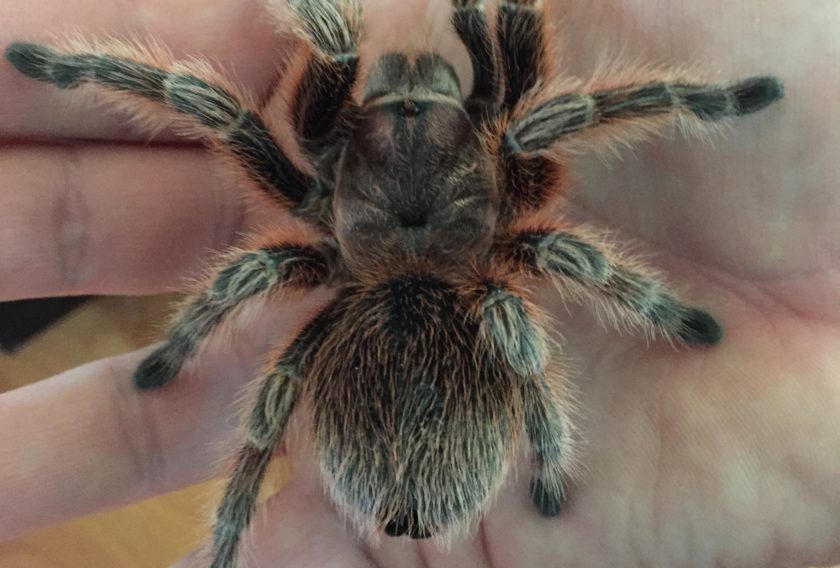
The proper care of the tarantula begins with understanding its nature, providing adequate habitat, serving nutritious diet and gentle handling. Tarantulas are one of the most striking arachnids that cultivate curiosity among everyone.
These are large spiders from the family Theraphosidae, that have longer lifespans.
Some species of the more common species have become popular in the exotic pet trade as they require less care from the keeper.
Most tropical, subtropical, and desert regions of the planet are home to hundreds of species of tarantulas. Their behavior and color vary depending on the surroundings in which they live.
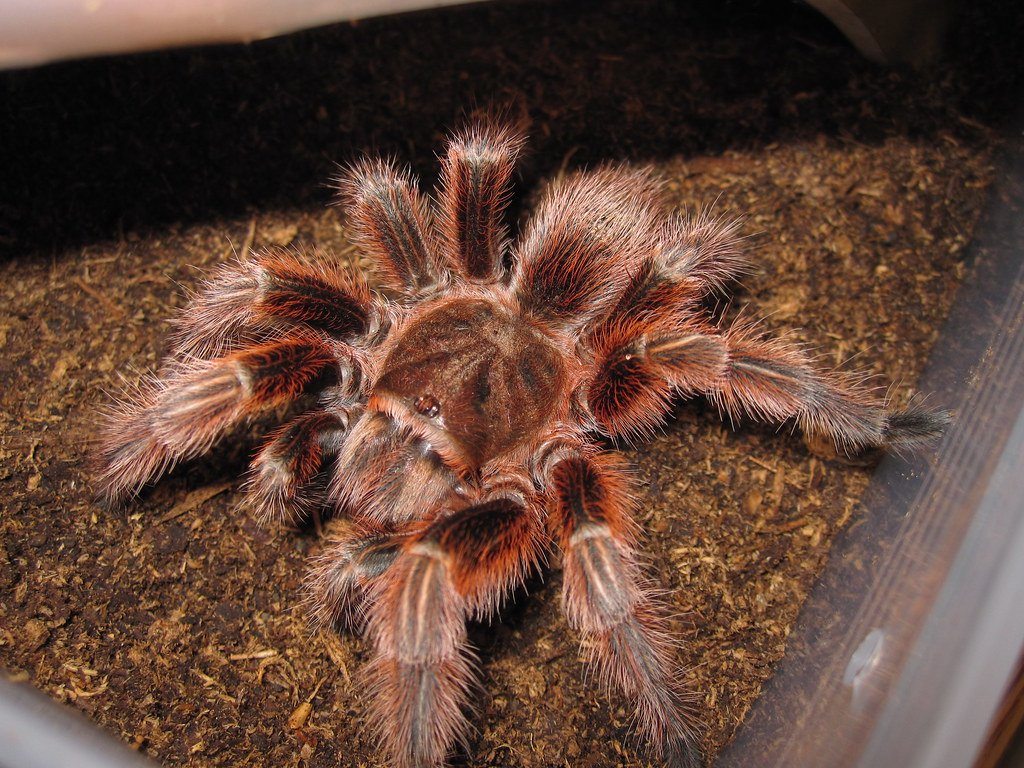
Here is a complete comprehensive care guide for pet tarantulas! Whether you’re a seasoned tarantula enthusiast or a beginner looking to welcome one of these fascinating creatures into your home, this guide has everything you need to know to provide the best care for your eight-legged friend.
Choosing the Right Enclosure
The first and foremost care for your tarantula begins with selection of an appropriate enclosure for your tarantula. The place where you plan to cherish and raise your eight-legged companion should replicate the wild and it should be more naturalistic. Your tarantula’s home is crucial to its well-being. As some species of tarantulas are cannibalistic, they should be housed in separate terrariums. The dimensions and orientation of the cage should be as per the size, species, and nature of your tarantula.
Setting up the Enclosure
You should set up the enclosure of your tarantula by taking the correct ratio of soil, coco peat, sphagnum moss in the substrate, hiding places, and suitable decors to mimic natural environment.
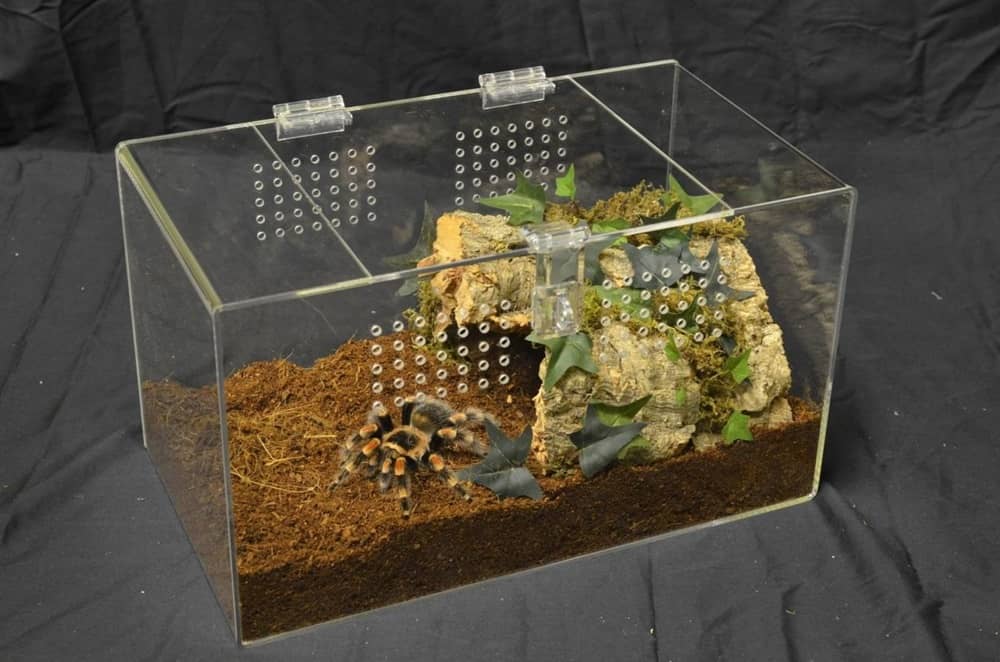
Tank Size
Looking after the proper enclosure size for your tarantula is crucial for its well-being and survival. When your tarantula is sling, you should keep it safe in a small container. This small chambered home will provide food in its close proximity.
An enclosure that is too large can lead to stress and difficulty in locating prey. For example , for a Curly hair tarantula , a small acrylic box or container of size [10” x 10”x 12.5”] is apt for spiderlings, a 2.5 -5 gallon size for juveniles and an 8-10 gallon size work well for an adult..
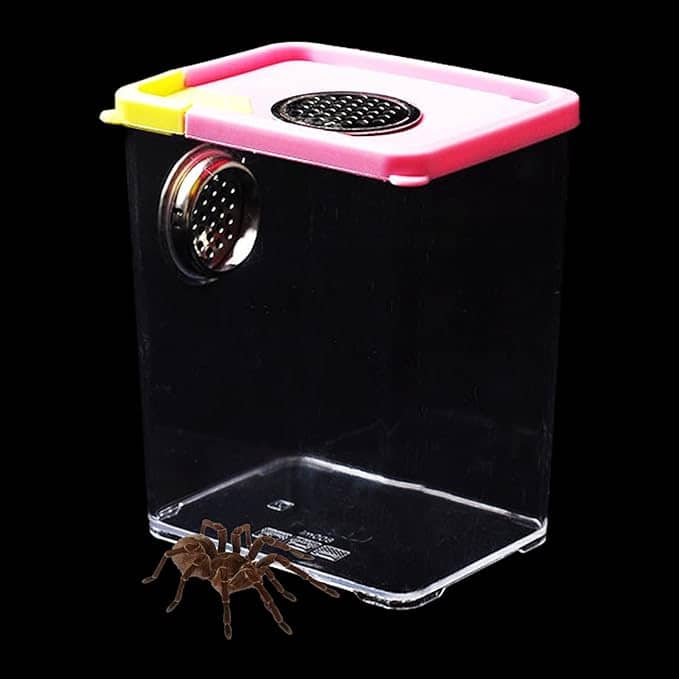
Temperature Requirements
The tarantulas thrive best in warm temperatures, so 75- 80 degrees Fahrenheit may be apt for keeping your tarantula happy. The tarantulas can adapt and tolerate easily some variations in temperature so you should not worry about procuring a heat mat if the temperature inside your house remains in this range. However, in extreme climatic changes, using a room heater is more beneficial as compared to a heating pad on one side of the enclosure.
Humidity Requirements
The humidity plays a vital role in the well-being of your tarantula. Some species such as Avicularia and Lasidora were once thought to be kept in humid regions only but they do well in dry conditions as well. A humidity level of 45-65% is required for better growth of your tarantula.
Keeping the substrate slightly damp either by misting or keeping a water dish inside the enclosure serves the purpose. Moreover, proper ventilation inside the cage is a must for keeping the air fresh all the time. It is maintained through small holes in the lid and the top sides of the enclosure.

A glass or plastic terrarium with secure ventilation to prevent escapes. The enclosure should be spacious enough for your tarantula to move around comfortably and furnished with substrate, hiding spots, and a shallow water dish.
Other Requirements In The Enclosure
The enclosure should be well decorated with some hiding spaces such as half-buried logs and pots. Additionally, fake plants, rock stones, and a small cork bark can enhance the beauty of the enclosure.
Tarantula Diet and Feeding Schedule
Tarantulas are carnivorous creatures that primarily love to feed on live prey. But to slings, you should offer pre-killed feed only. A variety of suitable prey items such as crickets, roaches, mealworms, and frozen mice can be given in moderate amounts to avoid overfeeding your tarantula.
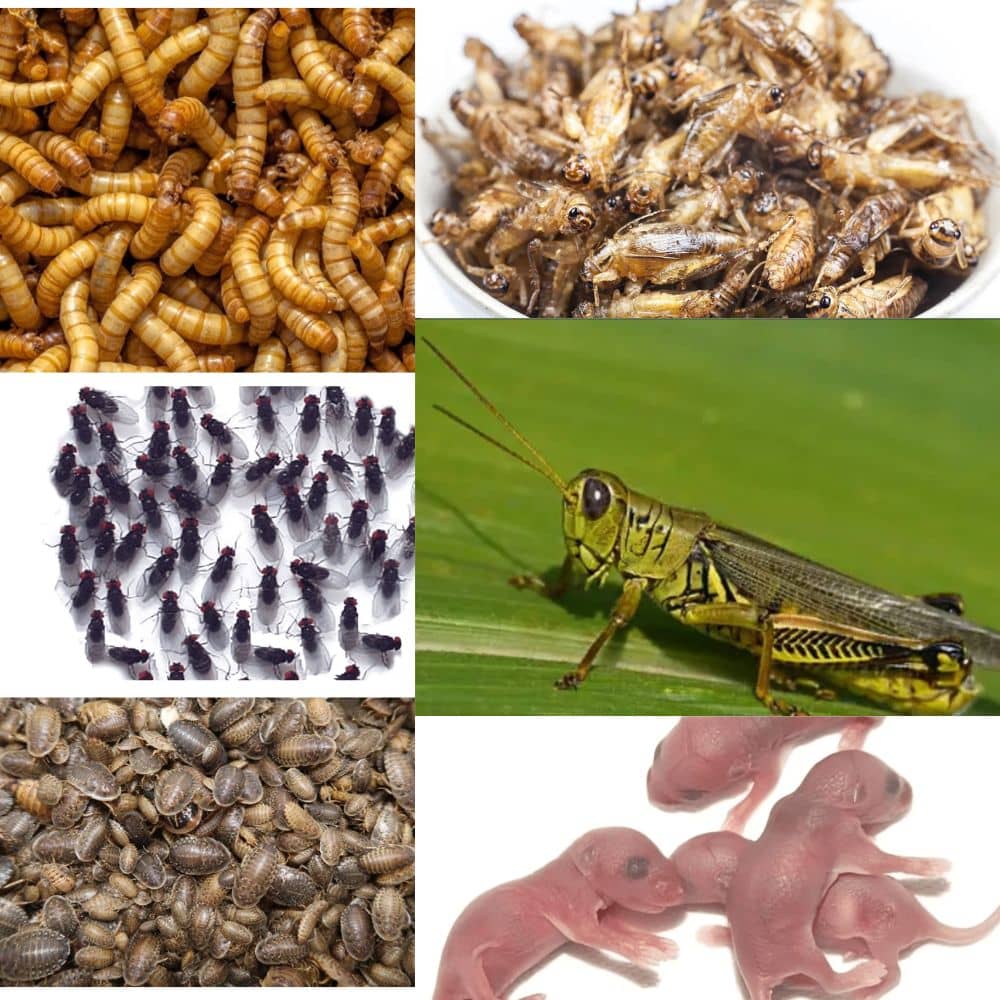
For instance, 1-2 small crickets every 10-14 days are served to slings of Aphonopelma Seemanni and 4-5 crickets are offered in 3-4 weeks to its adult. The diet and frequency can change for a particular species depending on its size.
Remember to gut load prey for optimal nutrition and offer prey items that are appropriate in size for your tarantula’s age and species.
How To Care For Health Of Your Tarantula?
Regularly monitor your tarantula for signs of good health, including active movement, a plump abdomen, and regular feeding behavior.
Keep an eye out for changes in behavior, appetite, or appearance, as these could indicate potential health issues that may require veterinary attention. With similar signs, your tarantula may be preparing itself for a molt.
Handling Your Tarantula
Handling tarantulas can be a rewarding experience for enthusiasts, but it’s essential to approach it with caution and respect for the spider’s well-being.
By understanding tarantula behavior, dispelling myths, and following safety precautions, you can enjoy interacting with these fascinating creatures while minimizing risk to both yourself and the spider. There are certain species such as Goliath Bird Eater tarantula, that should not be handled due to its aggressive nature. On the other hand, Pink Toe Tarantula, Chaco Golden Knee, and Chilean Rose Hair Tarantula are easy to handle.
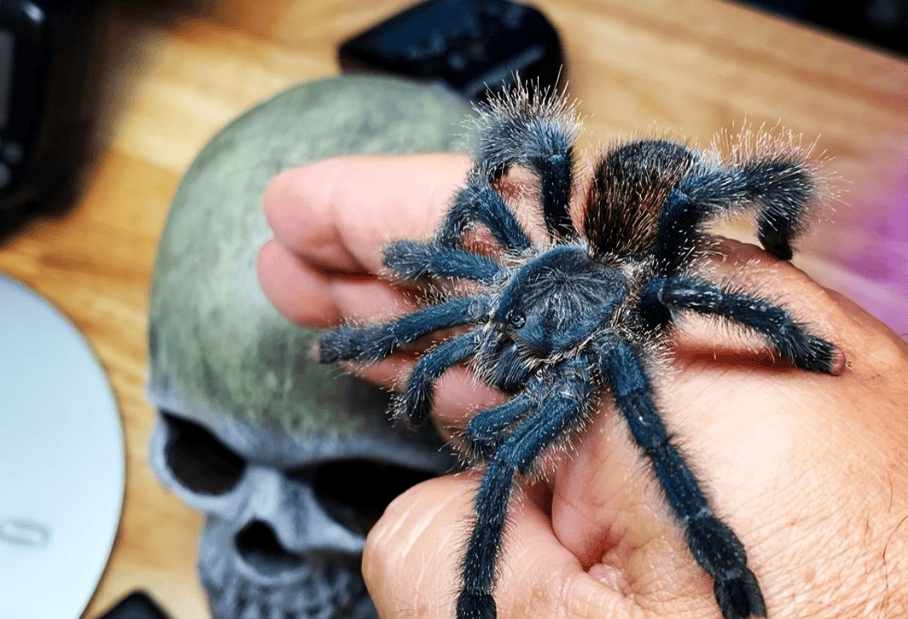
Remember, the key to successful tarantula handling is patience, gentleness, and a willingness to learn.
Easy To Care Tarantulas- Beginner – friendly tarantulas
There are many tarantulas that are easy to care, easy to handle, and recommended for keeping as a pet ,if you are a novice keeper. You should select your pet tarantula as per your compatibility, time and effort needed to cherish your pet.
A great choice for beginners is the Chilean Rose Hair Tarantula ( Grammostola Rosea ). This species is known for its docile temperament, ease of care, and striking appearance. Here’s a breakdown of its specific care requirements. When handling is necessary, try to approach the tarantula gently from the side and avoid sudden movements. If needed, encourage the tarantula to move using a soft brush rather than your hands.
Enclosure
Provide a 10-gallon terrarium with secure ventilation and a substrate depth of at least 3 inches.
Temperature And Humidity
Maintain temperatures between 70 -80°F (21-27°C) and humidity levels around 65%. Avoid excessive humidity to prevent respiratory issues.
Feeding
Offer appropriately sized live prey 1 2 times a week, adjusting frequency based on your tarantula’s appetite.
Handling
While Chilean Rose Hairs are generally docile, limit handling to minimize stress and avoid sudden movements.
Health Monitoring
Regularly observe your tarantula for signs of health issues for example, shrunken abdomen, lack of activity and loss of appetite are indication of some medical condition and need to be addressed. You should consult a veterinarian if you notice any abnormalities.
Habitat Cleaning And Sanitation
Maintaining a clean and hygienic habitat is essential for your tarantula’s health. Remove uneaten prey, molts, and feces promptly, and spot-clean any soiled substrate as needed. Periodically deep clean the enclosure by replacing the substrate and sanitizing decor items to prevent the buildup of harmful bacteria and mold.
Frequently Asked Questions About Care For Your Tarantula
1. How often should I feed my tarantula?
Answer: A tarantula can grow extremely quickly if fed every day. Offering food, however, should be done every 4–7 days for juvenile spiders and every 7–10 days for adult spiders.
2. Can I handle my tarantula?
Answer: It depends on the particular species you are willing to hold. For example, Chilean Rose, and Chaco Golden Knee are good for handling. You should approach your tarantula gently and avoid alarming it. You should not hold a tarantula for prolonged duration, this may put your tarantula under stress.
3. How do I know if my tarantula is molting?
Answer: If you observe a reduced appetite and lack of activity, your tarantula may be preparing for molting. It is often observed lying on its back when it is molting. The process of molting can last for few minutes to few hours.
4. What should I do if my tarantula stops eating?
Answer: You should not worry during initial times as tarantulas may undergo some fasting regime. You should remove uneaten prey and water should be refilled. Also, it should be first confirmed with the fact that it is not undergoing a molting process. You should consult a certified veterinarian if fasting continues.
5. How do I maintain the humidity in my tarantula’s enclosure?
Answer: Placing a water dish inside your terrarium can maintain the humidity levels. Also, slight misting can help to regulate moisture levels inside the cage. The enclosure of the tarantula should be well ventilated in order to regulate the temperature and humidity levels.
6. Is it normal for my tarantula to stay hidden all the time?
Answer: Yes, it is perfectly normal. Some species love to stay inside the burrow and other hiding places while some species like to wander inside the terrarium. For example Costa Rican Zebra Tarantula can be in its burrow for about a month.
7. Can tarantulas get sick?
Answer: Like every living creature, tarantulas may get sick. Shrunken abdomen, loss of appetite, and lack of activity may indicate that your tarantula is not keeping well. It may catch some kind of infection from the feed as well.
8. How long do tarantulas live?
Answer: Tarantulas are hardy creatures and life span varies from species to species. However, females have greater longevity of 15-25 years whereas males survive for a short duration of nearly 5-8 years.
9. Do tarantulas need special lighting?
Answer: Not necessarily. The tarantulas are nocturnal meaning they are more active during night time and do not specifically need special lighting.
10. How to keep updated about care for tarantula tips ?
Answer: You can join some facebook group or tarantula communities to keep yourself more updated.
By following these care guidelines and staying informed about your tarantula’s specific needs, you’ll be well-equipped to provide a safe, comfortable, and enriching environment for your fascinating arachnid companion.


